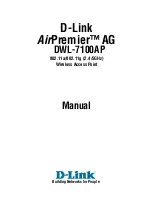
92
separated
by
“.”:
bbbbbbbb.bbbbbbbb.bbbbbbbb.bbbbbbbb,
where
each
“b”
can
either
be
0
or
1.
A
network
mask
is
also
a
32
‐
bit
binary
pattern,
and
consists
of
consecutive
leading
1’s
followed
by
consecutive
trailing
0’s,
such
as
11111111.11111111.11111111.00000000.
Therefore
sometimes
a
network
mask
can
also
be
described
simply
as
“x”
number
of
leading
1’s.
When
both
are
represented
side
by
side
in
their
binary
forms,
all
bits
in
the
IP
address
that
correspond
to
1’s
in
the
network
mask
become
part
of
the
IP
network
address,
and
the
remaining
bits
correspond
to
the
host
ID.
For
example,
if
the
IP
address
for
a
device
is,
in
its
binary
form,
11011001.10110000.10010000.00000111,
and
if
its
network
mask
is
11111111.11111111.11110000.00000000,
it
means
the
device’s
network
address
is
11011001.10110000.10010000.00000000
and
its
host
ID
is
00000000.00000000.00000000.00000111.
This
is
a
convenient
and
efficient
method
for
access
points
to
route
IP
packets
to
their
destination.
ISP
Gateway
Address:
(see
ISP
for
definition).
The
ISP
Gateway
Address
is
an
IP
address
for
the
Internet
access
point
located
at
the
ISP's
office.
ISP:
Internet
Service
Provider.
An
ISP
is
a
business
that
provides
connectivity
to
the
Internet
for
individuals
and
businesses
or
organizations.
LAN:
Local
Area
Network.
A
LAN
is
a
group
of
computers
and
devices
connected
together
in
a
relatively
small
area
(such
as
a
house
or
an
office).
Your
home
network
is
considered
a
LAN.
MAC
Address:
MAC
stands
for
Media
Access
Control.
A
MAC
address
is
the
hardware
address
of
a
device
connected
to
a
network.
The
MAC
address
is
a
unique
identifier
for
a
device
with
an
Ethernet
interface.
It
is
composed
of
two
parts:
3
bytes
of
data
corresponding
to
the
Manufacturer
ID
(unique
for
each
manufacturer)
plus
3
bytes
often
used
as
the
product’s
serial
number.
NAT:
Network
Address
Translation.
This
process
allows
all
of
the
computers
on
your
home
network
to
use
one
IP
address.
Using
the
broadband
access
point’s
NAT
capability,
you
can
access
the
Internet
from
any
computer
on
your
home
network
without
having
to
purchase
more
IP
addresses
from
your
ISP.
Summary of Contents for 525688
Page 16: ...13 A i ii iii ...
Page 17: ...14 B ...
Page 19: ...16 D E ...
Page 23: ...20 ...
Page 40: ...37 ...
Page 81: ...78 ...
Page 83: ...80 ...
Page 85: ...82 3 Click Local Area Connection 4 Click Properties ...
Page 87: ...84 ...
Page 90: ...87 5 Choose your connection and right click then select Properties ...






































